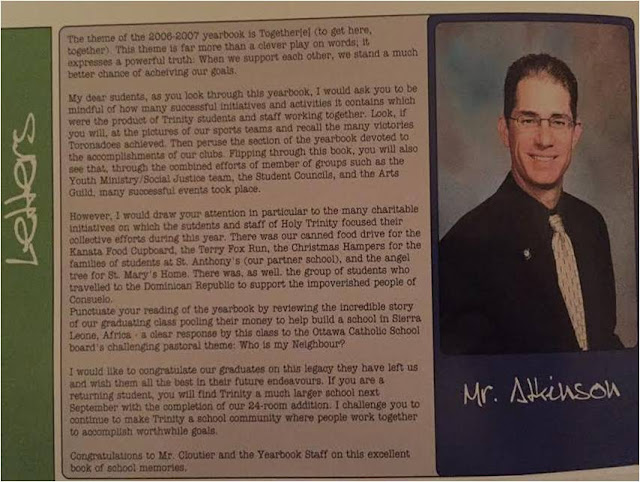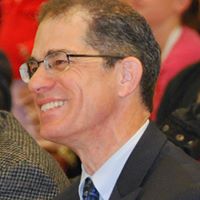MY TIME AS PRINCIPAL
It is important to bring broken people into a community of love, a
place where they feel accepted and recognized in their gifts, and
have a sense of belonging.
(Jean Vanier From Brokenness to Community)
Much has been written about the role of the principal. Traditionally, the principal has been viewed as a school administrator or facility manager who issues directives from the corner office. More recently, the role of the principal has been conceived as that of an instructional leader - one who, in reference to the word principal itself, serves as the main or lead teacher in the school.
Neither of these definitions of principal, however, captures fully either what I believed or experienced during the 6 years I spent in the principal's office in two Ottawa Catholic schools - Holy Trinity Catholic High School (2005-2009) and St. Francis Xavier High School (2009-2010).
Instead, my sense of the role of the principal is better reflected in the Jean Vanier quotation with which I began this post. For me, the principal work of a Catholic principal (pun intended) is to build a learning community in which all students and staff feel they are accepted and belong. Unless students feel included at, valued by, and connected to their school, and teachers and other staff feel the same, neither the best administrative planning for a school nor the most effective instructional practices in the classrooms will result in academic achievement for students and a sense of well-being for all at the school.
 |
| My Principal's Page in an edition of the Trinity Yearbook |
- Be more understanding
- Be more flexible
- Be more proactive
Inspired by Jean Vanier's philosophy of belonging and Dr. Bruce Ferguson's emphasis on a caring, positive school climate, I focused my work at Holy Trinity on developing an open, caring, and responsive school environment. During my first month as principal, I visited all homeroom classes to introduce myself and also met individually with all vice-principals, department heads, and curriculum leaders. I made certain that both students and staff had direct access to me. When I realized that some students and staff were hesitant to approach me in my office, I posted my Principal's Credo on my office door to make my intentions explicitly clear:
1. This door is always open to you.
2. Your interruptions are always welcome.
3. If I am not in my office when you drop by (hopefully, because I am out and about the
school), I will get back to you in a timely manner.
4. No one's dignity will be compromised in this office.
5. In this office, I will listen first, then speak.
6. In this office, our solution will be preferred to my or your solution.
I also made myself as available as possible by being in the school atrium before and after school and in the cafetorium and outside during lunch break. I attended as many after school activities as I could. I also often walked to and from school. Many mornings, as I approached the school, students were gathered outside the building, and I was able to take the pulse, so to speak, of the student body by speaking with these groups.
 |
| During my time as Principal of Holy Trinity a 24-room addition was added |
To build a sense of community among the staff, I profiled a different staff member in the Monday Morning Memo I issued every week. To gather interesting (and sometimes humorous) information on the staff member I was profiling, I would often call the spouse, creating a personal connection with him or her, too. The staff profiles I wrote were not only pleasant Monday morning surprises for the staff member I profiled, they were also effective ways to connect people at the school as they learned about their colleagues' backgrounds and interests.
As well, to promote a unifying sense of purpose among students and staff (what later writers termed uplift*), connecting with their hearts as well as their minds, I promoted well-established school-wide initiatives such as the annual Terry Fox Run and the Canned Food Drive.
 |
| The Annual Terry Fox Run/Walk at Holy Trinity was consistently one of the top 10 fundraising events of its kind in the province |
When it came to leading the instructional program at the school, I recognized from the onset that there were teachers at Holy Trinity who knew much more about their subject areas than I did, and that many good pedagogical practices were already being employed by many of the teachers. Having a background in literacy, I chose to lead in this area while allowing others at the school to lead in the equally important areas of numeracy and student pathways.
Years later, Michael Fullan wrote about the "dangerous half-truth" (Indelible Leadership, 12) of the principal improving student achievement by personally leading and micro-managing the instructional practices at the school. Instead, I was more comfortable with listening to the wisdom of the group, learning from it, and, accordingly, setting a course for innovation. In short, I adopted what Fullan later described as a lead learner role, and leveraged the power of the group "...to move the group." (Fullan The Principal, 29) Sometimes, I led the professional learning - as I did with the concept of teaching reading in the subject area. However, many times, I let teachers lead. What was critical, as Fullan noted in The Principal, was that although I as principal didn't always lead, I always participated. (86)
Surprisingly though, it wasn't Michael Fullan who primarily influenced me in taking, as principal, this lead learner stance. Instead, my inspiration came from a great book called Shepherd Leadership: Wisdom for Leaders from Psalm 23, written by Blaine McCormick and David Davenport. The quotation from that book that governed my approach to school leadership (and which I kept under the blotter on my desk) reads as follows: "To shepherd effectively, one must know when to lead, when to follow, and when to get out of the way." (51)


Many great initiatives that improved student engagement and achievement were launched by the talented staff at Holy Trinity during my time there as principal. One such initiative was Back on Track, which was a credit rescue program. Another innovation was an inter-disciplinary initiative whereby students could earn two grade 9 or 10 credits at a time by completing one set of assignments. In grade 9 Religion, experiential learning opportunities through the Shepherds of Good Hope and Kanata Food Cupboard were introduced. For grade 8 students at risk, we partnered with St. Nicholas High School to offer 'flash forward' grade 9 Hospitality and Travel & Tourism credits. I introduced an experiential learning opportunity for English classes whereby, a couple of times each year, students created an insert called The Trinity Times for the local Kanata Kourier-Standard newspaper. It was an opportunity for students to write for a real audience and to reflect on their learning and the positive climate at this great school.
 |
| Front page on one edition of the Holy Trinity Times |
* Uplifting Leadership, Andy Hargreaves, Alan Boyle, & Alma Harris















